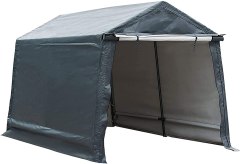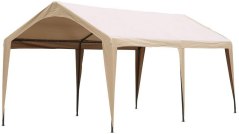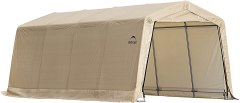BestReviews is reader-supported and may earn an affiliate commission. Details

Steel-frame style of carport that will stand up to tough weather nicely, while canopy protects against UV rays.
Steel-frame style of carport that will stand up to tough weather nicely, while canopy protects against UV rays.
Powder-coated steel frame measures 1.5 inches in diameter, providing a sturdy base. Includes a full-length gray polyethylene canopy that will keep your vehicle dry and protected from the sun. Canopy has a zippered door that you can remove if desired. Easily transportable design, as it breaks down to a small size.
Can be tricky for one person to assemble and disassemble. Price is on the high end.

Full-length style of carport canopy that makes it work great for both gatherings and to protect your vehicle.
Full-length style of carport canopy that makes it work great for both gatherings and to protect your vehicle.
Sides of canopy stretch to the ground, which helps the unit stand up better to windy conditions than some shorter canopies. Six metal leg poles give you a nice level of stability in the carport. Material in the canopy is able to block the dangerous UV rays from the sun, but it still allows some natural light inside the enclosure.
Will not hold up well to the weight of snow. Priced a little higher than some other options.

Six-legged carport with a metal frame that gives you a large coverage area at a low price point.
Six-legged carport with a metal frame that gives you a large coverage area at a low price point.
Versatile carport, as it's the perfect size for protecting your vehicle, as well as for using as shade for outdoor gatherings. Metal frame offers 6 legs to ensure maximum stability. Polyethylene canopy cover will stand up over time and resist ripping from age. Relatively easy to assemble when 2 people are involved.
May not stay in place well during heavy winds. Frame's strength is questionable in bad weather.

One of the best-looking carport canopies you'll find at a reasonable price point with good stability.
One of the best-looking carport canopies you'll find at a reasonable price point with good stability.
Carport consists of 6 steel legs that will give it a nice level of stability. Powder-coated steel frame with 1.5-inch diameter that will stand up to rust problems. Includes heavy-duty bungee cords to keep the canopy tarp tightly affixed to the frame. Provides a large coverage area for your vehicle.
Requires multiple people to assemble it. Will not stand up to heavy wind storms.

It uses steel frame poles to encourage stability while delivering protection from the sun.
It uses steel frame poles to encourage stability while delivering protection from the sun.
Frame's heavy-duty, powder-coated steel provides stability and resists rust. Triple-layer ripstop sandstone fabric blocks harmful sun rays and water. Large enough to provide protection for a vehicle or to provide shade for those at an outdoor gathering. Available as 10x15x8 or 10x20x8.
ShelterLogic recommends 2 people to assemble this product and estimates that the process will take about 6 hours.

We recommend these products based on an intensive research process that's designed to cut through the noise and find the top products in this space. Guided by experts, we spend hours looking into the factors that matter, to bring you these selections.

A carport is, first and foremost, a convenient and cost-effective way to protect one or more vehicles. It can be a cheap, simple construction for extra garage space without adding onto your home, or it can offer permanent cover for commercial vehicles, farm tractors, and implements.
If you search for carports online, you’ll also see many of these shelters described as outdoor canopies, party tents, or gazebos, and there’s no reason why they can’t do double duty if you’re hosting an outdoor celebration like a wedding.
Given their versatility and the variety of construction styles, sizes, and materials, it isn’t surprising that there are hundreds of different carports to choose from. It can be a little difficult to decide which one will suit your needs best, but we can help you. The following carport buying guide looks at specifications in more detail and answers several important questions.

Although the following features of carports are all very much interrelated, we can divide things into four specific areas: the kind of structure, its size, the frame, and the roof and sides.
Carports come as two quite distinct structures, one that’s attached to your house or one that’s freestanding.
Attached: This is a lean-to design that uses one wall of your house as support for the roof. It’s not a garage because it usually only has that one solid wall. The rest of the frame is frequently timber, but they can also be steel or aluminum. This type of carport is usually built as a permanent structure and intended to be very durable. It can also be quite expensive.
Freestanding: This type of carport, the one we’re focusing on here, comes in a number of guises. It can be a compact and lightweight structure providing short-term shelter for a single vehicle. It can be larger and more permanent, such as an RV carport, or it can be a large metal structure (resembling an open-sided barn) for long-term protection of vehicles and equipment. Indeed, the line between carport, barn, and steel building can sometimes get quite blurred, though, in general, we’re talking about structures that may have one side but aren’t fully enclosed.
If you have a specific vehicle to protect or a particular spot where you want your carport to sit, then size is a fairly straightforward decision. Height is a factor if you’re looking for an RV carport. It’s probably worth spending some time thinking about whether you could extend the carport’s usefulness by choosing something a little larger. It might then also provide a handy spot for a motorcycle, riding mower, ATV, barbecue grill, garden furniture, or other items that would benefit from some protection but don’t need to be stored indoors. A larger carport might free up valuable garage or shed space, too, something few people seem to have enough of.
Strength: The main job of the carport frame is to provide sufficient strength for the roof, so the diameter or cross section of the legs and roof members is important. Slender legs are fine on a lightweight, temporary structure, and they make it easy to assemble and disassemble the carport if you need to move it to another location. However, they may not be sturdy enough to support a roof that has a couple inches of snow on it.
If you’re intending to leave your carport up all year, you want to choose something substantial. Manufacturers don’t give load information on budget carports, so it’s worth checking online feedback from owners who have real-world experience to find out how a particular model copes with harsh conditions.
Anchors: In all cases, you also want to check for methods of anchoring your carport. Lightweight models might just have ground spikes, and as anyone who has put up a tent will tell you, these can be quite effective. At the other end of the scale, a carport with a large frame can have anchors buried in concrete or asphalt.
Material: Carport frames are invariably made of steel. On low-cost models it’s powder-coated steel (covered in a tough plastic skin) to resist rust. Larger models may be galvanized (dipped in molten zinc), which is much more robust and more expensive.
Frame construction also has an impact on the rigidity of larger carports, particularly double- and triple-wide models, and tall carports designed for RVs and trucks. You want to see strong, thick legs and plenty of bracing across joints. It’s also worth checking the thickness of the steel used. Common are 14- and 16-gauge steel (lower numbers mean thicker sheet metal).
Most people look at a carport as a way to keep the worst of the rain and snow off their vehicles and equipment, but they also provide important protection from the sun’s harmful UV rays, which will quickly fade paintwork and interiors.
Fabric: Synthetic fabric is used on budget and mid-priced carports, usually polyethylene (PE,) which is waterproofed, treated for UV protection, and may consist of several layers for increased toughness. For many people it’s perfectly acceptable, though it can be prone to damage from flying debris in stormy conditions. In case of damage, several manufacturers supply replacement covers, which is cheaper than buying a whole new carport.
Some canvas carports have sides. Some also have zippered doors and clear polyethene windows. While having sides increases protection, these carports need to be well secured or there’s a risk they’ll collapse in high winds.
Metal: On large carports, the roof is sheet steel or aluminum. The latter is lighter and less prone to corrosion. These materials offer greater protection from the elements and more durability than fabric, and they help provide the necessary rigidity over wide spans. Panels can be either horizontal (running from front to back of the carport) or vertical (running ground to roof). The latter is more efficient at draining rainwater and snow, which can collect in the channels on horizontal models.
Steel- and aluminum-clad carports may extend from the roof down the sides for a few feet, and they sometimes have gable ends, but they are otherwise open.
Some states require that new metal buildings be certified (whether open or enclosed), effectively ensuring that the manufacturer’s engineers have designed and tested the carport to withstand things like high winds and snow load. The rules are confusing, so it’s important to check your local building codes at the outset. If certification is required, you’ll need to anchor the carport to a concrete or asphalt slab. Check with the carport maker to find out what size this should be.

Inexpensive: The cheapest carports cost around $100 to $150. For this price you get a basic lightweight frame and roof for a single vehicle. It’s unlikely to have sides. These are fine for temporary use, but durability is a concern at this price point.
Mid-range: If you’re looking for a carport that completely encloses the vehicle and perhaps has windows, you’ll pay somewhere between $200 and $500. At these prices, the coverings are still fabric.
Expensive: Larger, semipermanent structures with a steel or aluminum roof start at around $1,000 and can exceed $6,000. The increased rigidity allows for double- and even triple-wide frames. For agricultural and commercial uses, it can be a very viable proposition.

Q. Do I need a building permit for a carport?
A. Many are classified as temporary structures, so it’s not often necessary. However, we can’t give a definite yes or no answer because every area is different. Size has an impact. In some cases, it makes a difference if the carport is for private or commercial purposes.
Even if a permit is not required, you still have to comply with local zoning bylaws, including possible certification (see above). It’s important to check. Erecting even a small carport without the necessary permissions could mean you have to take it down again. For those that do require a building permit, there is usually a fee.
Q. Can I put up my carport myself?
A. Many lightweight models are very straightforward and designed for DIY assembly. Larger semipermanent structures with aluminum paneling are still relatively uncomplicated, requiring little more than an adjustable wrench or socket set and an extra pair of hands.
However, if you’re building one of the more substantial rigid carports, you might want to consider hiring a licensed contractor, especially if you need a building permit. If you build it yourself, you take on the responsibility for anything that isn’t up to code. And if the inspector finds a problem, you have to rectify it. If you hire a contractor, it’s their responsibility. Obviously, the latter is more expensive, but it might be worth getting a couple quotes.
Q. How long does it take to install a carport?
A. We checked with several manufacturers, and the answers came back pretty much the same. Smaller models can take as little as a couple of hours, and larger rigid models up to 8 hours. This assumes a suitable base area has already been prepared.
Get emails you’ll love.
Learn about the products you’re wondering if you should buy and get advice on using your latest purchases.
